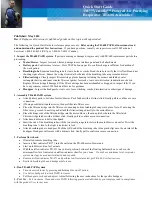
66433-YIM-B-1004
Unitary Products Group
15
SEQUENCE OF OPERATION
The unit is controlled by a conventional four wire heating/
cooling thermostat common to this class of equipment.
HEATING
When the thermostat calls for HEAT, the thermostat terminal
“W” is energized, the control board checks for a open pres-
sure switch “PS” and closed limit switches, then energizes
the combustion air blower.
After combustion airflow is established, the air proving pres-
sure switch “PS” closes, the hot surface ignitor is energized
and the pilot valve opens igniting the pilot flame.
The flame rod senses a flame and de-energizes the ignitor
opening the main gas valve and the main burners light.
30 seconds after the main burners light the circulating fan is
energized at the heating speed.
When the thermostat is satisfied, terminal W is de-energized,
de-energizing the ignition system closing the gas valve.
After a 5 second postpurge timing period, the combustion air
blower is de-energized and the heat fan off timing begins.
When this field selected heat fan off timing is completed the
circulating fan is de-energized.
If the limit switch “LS”, auxiliary limit switch “ALS” or the roll-
out switch “RS” open, the ignition system is de-energized and
the gas valve closes. The combustion blower and the circu-
lating fan are energized.
The combustion blower remains energized for the 5 second
postpurge timing period if the limit switch “LS”, auxiliary limit
switch “ALS” or the rollout switch “RS” contacts reset (the roll-
out “RS” and auxiliary limit switch “ALS” must be manually
reset). The circulating fan remains energized for the selected
heat delay off timing.
Normal operation of the system resumes.
HEATING SAFETY CONTROLS
The control circuit includes the following safety controls:
1.
Limit Switch (LS)
- This control is located inside the
heat exchanger compartment and is set to open at the
temperature indicated in the Temperature Controls Table
of the unit wiring diagram. It resets automatically. The
limit switch operates when a high temperature condition
caused by inadequate supply air flow occurs, thus shut-
ting down the ignition control and closing the main gas
valve and energizing the blower.
2.
Pressure Switch (PS)
- If the draft motor should fail, the
pressure switch prevents the ignition controls and gas
valves from being energized.
3.
Flame Sensor
- The flame sensor and controls are
located per Proper Flame Adjustment Figure 11. If an
ignition control fails to detect a signal from the flame sen-
sor indicating the pilot flame is properly ignited, then the
main gas valve will not open.
4.
Rollout Switch (RS)
- This switch is located in the
burner vestibule. In the event of a sustained main burner
flame rollout, it shuts off the ignition control and closes
the main gas valve.
NOTE:
The manual reset
Rollout Switch (RS)
must be
reset before allowing furnace operation.
5.
Auxiliary Limit Switch (ALS)
- This control is located
inside the heat exchanger compartment and is set to
open at 160°F. It is a manual reset switch. If ALS trips,
then the primary limit (LS) has not functioned correctly.
Replace the primary limit LS.
COOLING
When the thermostat calls for COOL, the thermostat termi-
nals G and Y are energized, which signals the compressor
and outdoor fan to run.
After a cool fan on delay timing of 2 seconds, the circulating
fan is energized at cooling speed.
When the thermostat is satisfied, terminals G and Y are de-
energized, de-energizing the compressor and outdoor fan.
After a cool fan off delay timing of 30 seconds, the circulating
fan is de-energized.
COOLING SAFETY CONTROLS
The control circuit includes the following safety controls:
1.
High Pressure Switch (HP)-
This switch protects
against excessive discharge pressures due to a blocked
condenser coil or a condenser motor failure (opens at
625 ± 25 psig and resets at 500 ± 25 psig).
2.
Low Pressure Switch (LP)-
This switch protects against
loss of refrigerant charge (opens at 7 ± 3 psig and resets
at 22 ± 5 psig).
The above pressure switches are specifically designed to
operate with R-410A systems. R-22 pressure switches
must
not
be used as replacements for the R-410A pressure
switches.
Summary of Contents for DNZ 060
Page 20: ...66433 YIM B 1004 20 Unitary Products Group FIGURE 13 TYPICAL WIRING DIAGRAM DNZ 208 230 1 60...
Page 21: ...66433 YIM B 1004 Unitary Products Group 21 FIGURE 14 TYPICAL WIRING DIAGRAM DNZ 208 230 3 60...
Page 22: ...66433 YIM B 1004 22 Unitary Products Group FIGURE 15 TYPICAL WIRING DIAGRAM DNZ 460 3 60...










































